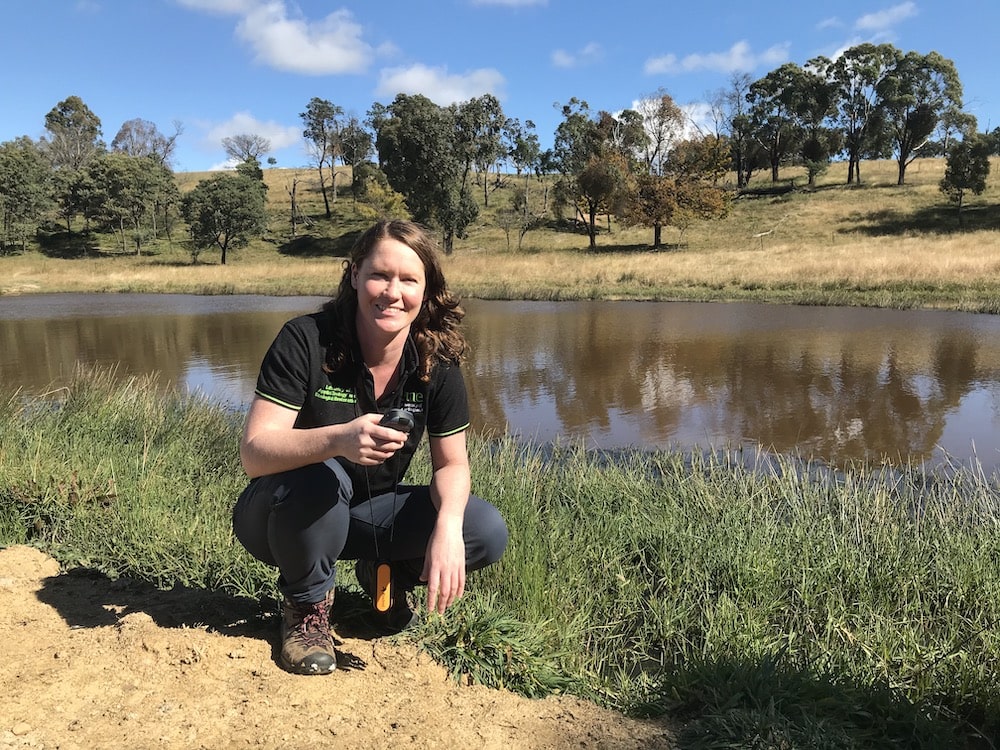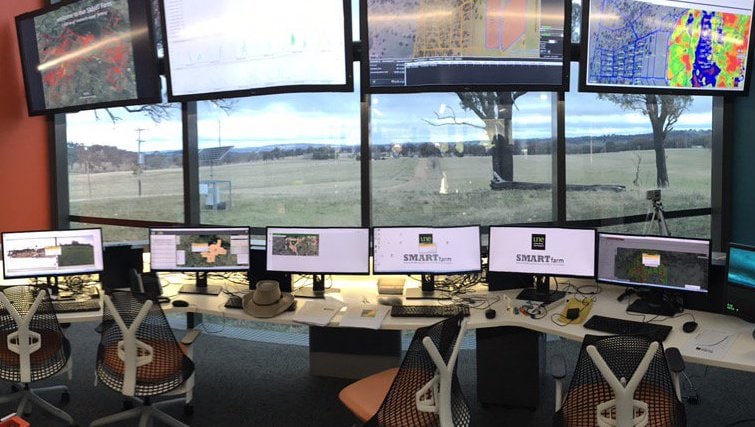The boundaries between ‘natural’ and agricultural/managed ecosystems have always been blurred so this month we head to the Northern Tablelands region of NSW, to look at the University of New England’s SMART Farms and the range of ecosystem observation data collected on properties used predominantly for agriculture.
The UNE SMART Farms are a group of grazing properties covering 3650ha used for commercial sheep and cattle production but also extensively for research, teaching and outreach. The SMART Farms provide the context for problem-based experiential learning for undergraduates and for research and community activities with most of the Farms within a 5 minute drive of the main UNE campus. The SMART Farms are home to the SMART Farm Innovation Centre (SFIC) launched in 2015.
The SFIC is a research, education and outreach facility built to showcase the integration of technology, science and farming. UNE researchers and their industry and community partners conduct world-class activities here, in a range of disciplines, including natural and agricultural ecosystems, poultry, livestock and canine sciences, precision agriculture and zoology.
Technology is pivotal to the SMART Farms and the SFIC is the physical hub of a network of on-farm connected devices. On-farm connectivity comprises the latest and emerging methods including store-and-forward and mesh telemetry, Long Range Wide Area Network (LoRA WAN), mobile phone network and satellite-direct. The networks are linked via fibre, fixed wireless and satellite national broadband network, and Australia’s Academic and Research Network (AARNet) national fibre network. The SFIC is an ‘instrumented’ research and teaching laboratory and the ultimate site to evaluate and inform innovations in practice and new technologies in a working farm environment.
The SMART Farms are an ideal environment for innovation in areas such as: spatially-enabled livestock management; telecommunication systems and Internet of Things (IoT); earth observation systems monitoring feed base and land use sustainability; datasets of soil, land types, pasture systems, elevation, weather and livestock health; remote & automated monitoring systems; and data integration to assess the effectiveness of management decisions and optimise planning of new infrastructure. The SFIC provides a base for research in these areas but also serves as an education and outreach facility to connect researchers with producers, industry and the community.
There are currently 56 different projects being conducted across the Farms with at least 42 staff and 30 postgrads doing work ranging from genetics of feed efficiency in beef cattle at the feedlot at Tullimba through to monitoring areas of tree regeneration by onsite surveys and remote monitoring along with crop and pasture trials, dung beetle monitoring, seed dispersal trials and grazing behaviour.
How can farm dams contribute to biodiversity on farm?
Farm dams across Australia have a vital role to play in conserving native animals, without compromising agricultural production. University of New England aquatic biologist Dr Debbie Bower is about to test this hypothesis as part of a $425,469 Australian Research Council grant.
While primarily a water storage for agricultural use, there is evidence that more than two million farms dams in Australia – at least 9% of our stored water – also provide a critical refuge for freshwater animals. With agricultural production set to double by 2050 to meet increasing demand, impact on the biodiversity these dams support could also grow.
“The loss and degradation of many natural wetlands in Australia has seen these additional sources of water become important resources in the landscape.
My project will look at whether farm dam management that benefits production through cleaner water has dual benefits for the frogs, birds, reptiles and bugs that also live there. We will explore whether these two goals are mutually exclusive.”
Dr Debbie Bower, UNE

UNE aquatic biologist Dr Debbie Bower
Some landholders already recognise the ecosystem services that maintaining biodiversity and wildlife provides – mainly through better water quality, windbreaks, pollination, stabilising topsoil, flood control and nutrient cycling – however relatively few have moved to fence off dams and provide troughs for cattle instead.
“These are two of the main mechanisms for managing dams to maintain water quality suited to native animals,” Debbie says. “There is some evidence that when livestock have cleaner water they will drink more, and when they drink more, they will eat more and put on weight faster.”
“If farm dams are not managed properly, their water can become silty and turbid, water retention is decreased and aquatic vegetation destroyed. These changes will reduce the usefulness of the dam for both livestock and wildlife.”
The study of farm dams on the Northern Tablelands of NSW will look at the economic and environmental trade-offs of different farm dam management and when using such measures is appropriate.
“Often the management strategies that are the most economical and sustainable in the long-term are also good for wildlife and biodiversity,” Debbie says.
“Some landholders are really interested in how the environmental world and the agricultural world can benefit one another, even diversifying to introduce nature viewing and ecotourism on their properties.”
Debbie and her team will test water quality and check for the presence of native species (including macro-invertebrates, fish, reptiles and frogs) in farm dams that are managed under a range of conditions and compare this to naturally occurring wetlands. They will also conduct experiments at the UNE SMART Farms to compare when dams are accessed by cattle and when they are not, to determine whether improved water quality correlates with improved livestock productivity.
With freshwater native species disproportionately more threatened than other species – over 40% of frogs, alone, are threatened with extinction – time is of the essence.
“We are undergoing a sixth mass extinction event on Earth,” Debbie says. “Finding ways to grow food that minimises environmental impacts is going to be really important to maintaining biodiversity.
“We already know that frogs, for instance, play important roles in the ecosystem predating on bugs and other insects, providing food for birds and mammals, and as tadpoles graze algae in wetlands.
If you lose too many frogs, or too many species of any kind, this food web breaks down and we start to lose the broader benefits biodiversity delivers to a landscape.”
Field work will begin in earnest in September 2020 -March 2021, when reptiles, amphibians and insects are most active, however acoustic recorders will be installed in the next few months to provide an indication of frog reproduction and hydrological changes in the dams.
This study builds on Dr Bower’s recent work with Dr Manu Saunders and Dr John Hunter, supported by the NSW Environmental Trust, to explore how species use threatened upland lagoons, and how lagoon management influences the abundance and composition of species. There are just 58 upland lagoons – a threatened ecological community – left on the Northern Tablelands, most of them on private properties.







